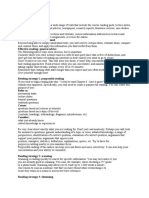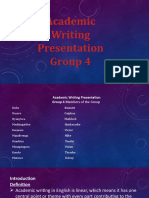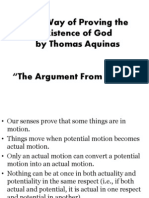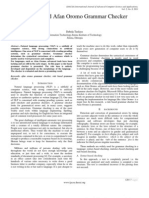Content: How To Read An Assignment Argument in Academic Writing
Content: How To Read An Assignment Argument in Academic Writing
Uploaded by
Clarisse LaoCopyright:
Available Formats
Content: How To Read An Assignment Argument in Academic Writing
Content: How To Read An Assignment Argument in Academic Writing
Uploaded by
Clarisse LaoOriginal Title
Copyright
Available Formats
Share this document
Did you find this document useful?
Is this content inappropriate?
Copyright:
Available Formats
Content: How To Read An Assignment Argument in Academic Writing
Content: How To Read An Assignment Argument in Academic Writing
Uploaded by
Clarisse LaoCopyright:
Available Formats
Get some distance from the text!
Its hard to edit or proofread a paper that youve just finished writingits still to familiar, and you tend to skip over a lot of errors. Put the paper aside for a few hours, days, or weeks. Go for a run. Take a trip to the beach. Clear your head of what youve written so you can take a fresh look at the paper and see what is really on the page. Better yet, give the paper to a friendyou cant get much more distance than that. Someone who is reading
the paper for the first time, comes to it with completely fresh eyes. Decide what medium lets you proofread most carefully. Some people like to work right at the computer, while others like to sit back with a printed copy that they can mark up as they read. Try changing the look of your document. Altering the size, spacing, color, or style of the text may trick your brain into thinking its seeing an unfamiliar document, and that can help you get a different perspective on what youve written.
Find a quiet place to work. Dont try to do your proofreading in front of the TV or while youre chugging away on the treadmill. Find a place where you can concentrate and avoid distractions. If possible, do your editing and proofreading in several short blocks of time, rather than all at onceotherwise, your concentration is likely to wane. If youre short on time, you may wish to prioritize your editing and proofreading tasks to be sure that the most important ones are completed.
EDITING
Editing is what you begin doing as soon as you finish your first draft. You reread your draft to see, for example, whether the paper is well-organized, the transitions between paragraphs are smooth, and your evidence really backs up your argument. You can edit on several levels:
Content
Have you done everything the assignment requires? Are the claims you make accurate? If it is required to do so, does your paper make an argument? Is the argument complete? Are all of your claims consistent? Have you supported each point with adequate evidence? Is all of the information in your paper relevant to the assignment and/or your overall writing goal? (For additional tips, see our handouts on how to read an assignment and argument in academic writing.)
Overall structure
Does your paper have an appropriate introduction and conclusion? Is your thesis clearly stated in your introduction? Is it clear how each paragraph in the body of your paper is related to your thesis? Are the paragraphs arranged in a logical sequence? Have you made clear transitions between paragraphs? One way to check the structure of your paper is to make an outline of the paper after you have written the first draft. (See our handouts on introductions, conclusions, constructing thesis statements, and transitions.)
Structure within paragraphs
Does each paragraph have a clear topic sentence? Does each paragraph stick to one main idea? Are there any extraneous or missing sentences in any of your paragraphs? (See our handout on paragraph development.)
Clarity
Have you defined any important terms that might be unclear to your reader? Is the meaning of each sentence clear? (One way to answer this question is to read your paper one sentence at a time, starting at the end and working backwards so that you will not unconsciously fill in content from
previous sentences.) Is it clear what each pronoun (he, she, it, they, which, who, this, etc.) refers to? Have you chosen the proper words to express your ideas? Avoid using words you find in the thesaurus that arent part of your normal vocabulary; you may misuse them.
Style
Have you used an appropriate tone (formal, informal, persuasive, etc.)? Is your use of gendered language (masculine and feminine pronouns like he or she, words like fireman that contain man, and words that some people incorrectly assume apply to only one genderfor example, some people assume nurse must refer to a woman) appropriate? Have you varied the length and structure of your sentences? Do you tends to use the passive voice too often? Does your writing contain a lot of unnecessary phrases like there is, there are, due to the fact that, etc.? Do you repeat a strong word (for example, a vivid main verb) unnecessarily? (For tips, see our handouts on style and gendersensitive language.)
Citations
Have you appropriately cited quotes, paraphrases, and ideas you got from sources? Are your citations in the correct format? (See theUNC Libraries citation tutorial for more information.) As you edit at all of these levels, you will usually make significant revisions to the content and wording of your paper. Keep an eye out for patterns of error; knowing what kinds of problems you tend to have will be helpful, especially if you are editing a large document like a thesis or dissertation. Once you have identified a pattern, you can develop techniques for spotting and correcting future instances of that pattern. For example, if you notice that you often discuss several distinct topics in each paragraph, you can go through your paper and underline the key words in each paragraph, then break the paragraphs up so that each one focuses on just one main idea.
PROOFREADING
Proofreading is the final stage of the editing process, focusing on surface errors such as misspellings and mistakes in grammar and punctuation. You should proofread only after you have finished all of your other editing revisions.
Why proofread? Its the content that really matters, right?
Content is important. But like it or not, the way a paper looks affects the way others judge it. When youve worked hard to develop and present your ideas, you dont want careless errors distracting your reader from what you have to say. Its worth paying attention to the details that help you to make a good impression. Most people devote only a few minutes to proofreading, hoping to catch any glaring errors that jump out from the page. But a quick and cursory reading, especially after youve been working long and hard on a paper, usually misses a lot. Its better to work with a definite plan that helps you to search systematically for specific kinds of errors. Sure, this takes a little extra time, but it pays off in the end. If you know that you have an effective way to catch errors when the paper is almost finished, you can worry less about editing while you are writing your first drafts. This makes the entire writing proccess more efficient. Try to keep the editing and proofreading processes separate. When you are editing an early draft, you dont want to be bothered with thinking about punctuation, grammar, and spelling. If your worrying
about the spelling of a word or the placement of a comma, youre not focusing on the more important task of developing and connecting ideas.
The proofreading process
You probably already use some of the strategies discussed below. Experiment with different tactics until you find a system that works well for you. The important thing is to make the process systematic and focused so that you catch as many errors as possible in the least amount of time.
Dont rely entirely on spelling checkers. These can be useful tools but they are far from foolproof. Spell checkers have a limited dictionary, so some words that show up as misspelled may really just not be in their memory. In addition, spell checkers will not catch misspellings that form another valid word. For example, if you type your instead of youre, to instead of too, or there instead of their, the spell checker wont catch the error.
Grammar checkers can be even more problematic. These programs work with a limited number of rules, so they cant identify every error and often make mistakes. They also fail to give thorough explanations to help you understand why a sentence should be revised. You may want to use a grammar checker to help you identify potential run-on sentences or toofrequent use of the passive voice, but you need to be able to evaluate the feedback it provides.
Proofread for only one kind of error at a time. If you try to identify and revise too many things at once, you risk losing focus, and your proofreading will be less effective. Its easier to catch grammar errors if you arent checking punctuation and spelling at the same time. In addition, some of the techniques that work well for spotting one kind of mistake wont catch others.
Read slow, and read every word. Try reading out loud, which forces you to say each word and also lets you hear how the words sound together. When you read silently or too quickly, you may skip over errors or make unconscious corrections.
Separate the text into individual sentences. This is another technique to help you to read every sentence carefully. Simply press the return key after every period so that every line begins a new sentence. Then read each sentence separately, looking for grammar, punctuation, or spelling errors. If youre working with a printed copy, try using an opaque object like a ruler or a piece of paper to isolate the line youre working on.
Circle every punctuation mark. This forces you to look at each one. As you circle, ask yourself if the punctuation is correct.
Read the paper backwards. This technique is helpful for checking spelling. Start with the last word on the last page and work your way back to the beginning, reading each word separately. Because content, punctuation, and grammar wont make any sense, your focus will be entirely on the spelling of each word. You can also read backwards sentence by sentence to check grammar; this will help you avoid becoming distracted by content issues.
Proofreading is a learning process. Youre not just looking for errors that you recognize; youre also learning to recognize and correct new errors. This is where handbooks and dictionaries come in. Keep the ones you find helpful close at hand as you proofread.
Ignorance may be bliss, but it wont make you a better proofreader. Youll often find things that dont seem quite right to you, but you may not be quite sure whats wrong either. A word looks like it might be misspelled, but the spell checker didnt catch it. You think you need a comma between two words, but youre not sure why. Should you use that instead of which? If youre not sure about something, look it up.
The proofreading process becomes more efficient as you develop and practice a systematic strategy. Youll learn to identify the specific areas of your own writing that need careful attention, and knowing that you have a sound method for finding errors will help you to focus more on developing your ideas while you are drafting the paper.
You might also like
- PWC - Writing Tip Vol2 FinalDocument130 pagesPWC - Writing Tip Vol2 FinalBao NgocNo ratings yet
- Administrative Issues JournalDocument14 pagesAdministrative Issues JournalDane SinclairNo ratings yet
- LitbasedmgpDocument3 pagesLitbasedmgpapi-301429689No ratings yet
- ResearchdesignDocument3 pagesResearchdesignapi-301429689No ratings yet
- Top 10 Free Plagiarism Detection ToolsDocument11 pagesTop 10 Free Plagiarism Detection ToolsBiswajit Debnath100% (1)
- Self Editing ChecklistDocument2 pagesSelf Editing ChecklistSanjay JoshiNo ratings yet
- Reading SkillsDocument4 pagesReading SkillsAmna ShoukatNo ratings yet
- How To Write Clearly and ConciselyDocument3 pagesHow To Write Clearly and ConciselyAvelardo ObligadoNo ratings yet
- Ten Essential Features of Academic WritingDocument2 pagesTen Essential Features of Academic WritingVita BonumNo ratings yet
- Skills in ReadingDocument15 pagesSkills in ReadingRara Rahman PutriNo ratings yet
- Reading Strategies and SkillsDocument6 pagesReading Strategies and SkillsDesnitaNo ratings yet
- 10 Tips On How We Write PapersDocument3 pages10 Tips On How We Write PapersJunbo LuNo ratings yet
- Essay/Report Writing - Some Guidelines: AnalyseDocument5 pagesEssay/Report Writing - Some Guidelines: Analysemazzmazzmazz8No ratings yet
- Overcoming Procrastination: Your Ultimate Guide to Stop Delaying and Start Living Your Best LifeFrom EverandOvercoming Procrastination: Your Ultimate Guide to Stop Delaying and Start Living Your Best LifeNo ratings yet
- How to Speak and Write Correctly: Study Guide (English + Chinese Traditional)From EverandHow to Speak and Write Correctly: Study Guide (English + Chinese Traditional)Rating: 3 out of 5 stars3/5 (19)
- The Process of Essay WritingDocument4 pagesThe Process of Essay WritingMeem RahmanNo ratings yet
- Academic WritingDocument4 pagesAcademic WritingOyon Nur newazNo ratings yet
- Women in LeadershipDocument12 pagesWomen in Leadershipapi-296422388No ratings yet
- Tips For Essay WritingDocument2 pagesTips For Essay WritingKrishna ChythanyaNo ratings yet
- How To Write A Research Paper in 9 StepsDocument10 pagesHow To Write A Research Paper in 9 StepsjhonramosdiocadesNo ratings yet
- 2022 Academic Writing GuideDocument12 pages2022 Academic Writing GuideNamita GoburdhanNo ratings yet
- 10 Tips On How To Improve Your WritingDocument11 pages10 Tips On How To Improve Your WritingSimonaSimNo ratings yet
- In Text CitationsDocument3 pagesIn Text CitationsCristian BossioNo ratings yet
- The High Performer's Students Guide: Learning Strategies for Students to Score High with Less Effort: Self HelpFrom EverandThe High Performer's Students Guide: Learning Strategies for Students to Score High with Less Effort: Self HelpNo ratings yet
- Provide One Piece of Text From Today's Reading To Support Your PredictionDocument10 pagesProvide One Piece of Text From Today's Reading To Support Your Predictionsam91879No ratings yet
- The Lost Art of Closing: Winning the Ten Commitments That Drive SalesFrom EverandThe Lost Art of Closing: Winning the Ten Commitments That Drive SalesRating: 3 out of 5 stars3/5 (4)
- How To Write A SummaryDocument5 pagesHow To Write A SummaryNauman MashwaniNo ratings yet
- Course Reflection English 1301-054Document3 pagesCourse Reflection English 1301-054api-520761590No ratings yet
- How to Pass Job Interviews with Ease: Critical Mistakes to AvoidFrom EverandHow to Pass Job Interviews with Ease: Critical Mistakes to AvoidNo ratings yet
- The Craft of Professional Writing: A Guide for Amateur and Professional WritersFrom EverandThe Craft of Professional Writing: A Guide for Amateur and Professional WritersNo ratings yet
- PMR Writing TipsDocument6 pagesPMR Writing TipsNadiah Bt Mohd AbdahNo ratings yet
- Build Fluency Muscle: Three Six-Week Programs to Improve Writing FluencyFrom EverandBuild Fluency Muscle: Three Six-Week Programs to Improve Writing FluencyNo ratings yet
- Applied Doctoral Project HandbookDocument83 pagesApplied Doctoral Project HandbookMuhammad Riza AlifiNo ratings yet
- Academic Essays: Form and Function: The Structure of A 1000-3000 Word EssayDocument2 pagesAcademic Essays: Form and Function: The Structure of A 1000-3000 Word EssayNgô Hoàng Bích KhaNo ratings yet
- Academic Writing and Critical Analysis: Studying in Higher EducationDocument4 pagesAcademic Writing and Critical Analysis: Studying in Higher EducationStanley IheukoNo ratings yet
- How To Write A Scientific PaperDocument3 pagesHow To Write A Scientific Paperapi-260736082No ratings yet
- Paraphrasing Difficult TextsDocument11 pagesParaphrasing Difficult TextsKhushboo VermaNo ratings yet
- Practical Tips For Doctoral StudentsDocument32 pagesPractical Tips For Doctoral StudentsSonja StojadinovicNo ratings yet
- English Language, Literature and Creative Writing: A Practical Guide for StudentsFrom EverandEnglish Language, Literature and Creative Writing: A Practical Guide for StudentsNo ratings yet
- How To Make A Best PaperDocument11 pagesHow To Make A Best PaperSoeryawan GilangNo ratings yet
- Writing Tips: Thesis: Which SectionsDocument4 pagesWriting Tips: Thesis: Which SectionsAsanka RodrigoNo ratings yet
- Stages of The Writing Process: Prewriting: Prewriting Is Everything You Do Before You Begin To Draft The Paper. Look Over An Assignment HandoutDocument2 pagesStages of The Writing Process: Prewriting: Prewriting Is Everything You Do Before You Begin To Draft The Paper. Look Over An Assignment HandoutKainat TufailNo ratings yet
- Eat Your Words Translation RatesDocument3 pagesEat Your Words Translation RatesSam M. JamiesonNo ratings yet
- Emerging Perspectives in Educational Leadership: Topic - 1Document25 pagesEmerging Perspectives in Educational Leadership: Topic - 1Marcia PattersonNo ratings yet
- The Gift: Sharing Your Life Lessons with the People You Love MostFrom EverandThe Gift: Sharing Your Life Lessons with the People You Love MostNo ratings yet
- Set Priorities & Plan Success: incl. Bonus – Become more Productive, make the right Decisions, stop to Postpone Delay Defer or Avoid things, improve Efficiency & Time Management for Chaotic PeopleFrom EverandSet Priorities & Plan Success: incl. Bonus – Become more Productive, make the right Decisions, stop to Postpone Delay Defer or Avoid things, improve Efficiency & Time Management for Chaotic PeopleNo ratings yet
- CV Writing: 3-in-1 Guide to Master Curriculum Vitae Templates, Resume Writing Guide, CV Building & How to Write a ResumeFrom EverandCV Writing: 3-in-1 Guide to Master Curriculum Vitae Templates, Resume Writing Guide, CV Building & How to Write a ResumeNo ratings yet
- How To Teach Expository Text Structure To Facilitate Reading ComprehensionDocument4 pagesHow To Teach Expository Text Structure To Facilitate Reading ComprehensionDemona ValentineNo ratings yet
- Process WritingDocument14 pagesProcess WritingErick CastilloNo ratings yet
- Writing A Lab Report: TitleDocument11 pagesWriting A Lab Report: TitleGus Ostow100% (1)
- Precis Writing Tips and Examples - PDF - Bank Exams TodayDocument7 pagesPrecis Writing Tips and Examples - PDF - Bank Exams Todaysaikiran1412No ratings yet
- APA Reference CitationsDocument5 pagesAPA Reference Citationsladyjennie100% (1)
- Summary WritingDocument4 pagesSummary Writingeng_iqbalNo ratings yet
- Academic Writing Presantation PowerPointDocument58 pagesAcademic Writing Presantation PowerPointkundayi shavaNo ratings yet
- Writing Tips 1Document7 pagesWriting Tips 1THE THIZZNo ratings yet
- Communication Process: Mrs. Dayley Business CommunicationsDocument15 pagesCommunication Process: Mrs. Dayley Business CommunicationsClarisse LaoNo ratings yet
- FO Chap 1Document24 pagesFO Chap 1Clarisse LaoNo ratings yet
- History of TourismDocument12 pagesHistory of TourismClarisse LaoNo ratings yet
- Reaction Paper - RizalDocument1 pageReaction Paper - RizalClarisse LaoNo ratings yet
- Desire's Unlikely EndDocument10 pagesDesire's Unlikely EndClarisse Lao67% (6)
- First Way of Proving The Existence of GodDocument3 pagesFirst Way of Proving The Existence of GodClarisse LaoNo ratings yet
- Cabacus: Æcô Æcd ÆcdDocument5 pagesCabacus: Æcô Æcd ÆcdClarisse LaoNo ratings yet
- History of Food Service IndustryDocument10 pagesHistory of Food Service IndustryClarisse LaoNo ratings yet
- 12 Useful Microsoft Word Tips and TricksDocument14 pages12 Useful Microsoft Word Tips and TricksJiana NasirNo ratings yet
- Module 4 (Computing Fundamentals)Document12 pagesModule 4 (Computing Fundamentals)Queven James EleminoNo ratings yet
- EAPP Survey QuestionnaireDocument23 pagesEAPP Survey QuestionnaireAurora FontanillaNo ratings yet
- Word Assignment 3Document5 pagesWord Assignment 3asimraza1472No ratings yet
- EditingDocument8 pagesEditingGenelahNo ratings yet
- Grammar CheckerDocument6 pagesGrammar CheckerInternational Journal of Innovative Science and Research TechnologyNo ratings yet
- A Rule-Based Afan Oromo Grammar CheckerDocument5 pagesA Rule-Based Afan Oromo Grammar CheckerEditor IJACSANo ratings yet
- Free Grammar Checker - QuillBot AIDocument1 pageFree Grammar Checker - QuillBot AIEsraa MostafaNo ratings yet
- PCX - Report 1Document22 pagesPCX - Report 1Molalegn BezieNo ratings yet
- Mery Dina Amelia 1835511016Document8 pagesMery Dina Amelia 1835511016Hindi ako goodsNo ratings yet
- Effectiveness of Online Grammar Checkers in Editing The Academic Texts of The LearnersDocument15 pagesEffectiveness of Online Grammar Checkers in Editing The Academic Texts of The LearnersDoc JeungNo ratings yet
- The 101 Best Websites For Esl Students in 2016Document16 pagesThe 101 Best Websites For Esl Students in 2016api-245053145No ratings yet
- CS Projects (2020 21 Mphaka M)Document4 pagesCS Projects (2020 21 Mphaka M)rick sanchezNo ratings yet
- An API To Check Spelling and GrammarDocument29 pagesAn API To Check Spelling and GrammarrsmudgeNo ratings yet
- Editing and Proofreading: Revision, Editing & Proof ReadingDocument6 pagesEditing and Proofreading: Revision, Editing & Proof ReadingAdeel RazaNo ratings yet
- Andare Italian VerbsDocument3 pagesAndare Italian Verbsmeliancurtean4659No ratings yet
- BookDocument185 pagesBookmidoNo ratings yet
- FRW3 TMDocument62 pagesFRW3 TMhamhum saralopNo ratings yet
- ComputerDocument3 pagesComputertembo2228No ratings yet
- Conjugator Reverso Net Conjugation Italian Verb Essere HTMLDocument3 pagesConjugator Reverso Net Conjugation Italian Verb Essere HTMLmeliancurtean4659No ratings yet
- W5 - Word Processing - MODULE - PDF - 2Document11 pagesW5 - Word Processing - MODULE - PDF - 2Russel SantosNo ratings yet
- Constructive ToolsDocument3 pagesConstructive ToolsnessaNo ratings yet
- Computer Assisted Language Learning (CALL) in BangladeshDocument80 pagesComputer Assisted Language Learning (CALL) in BangladeshAfroza miliNo ratings yet
- Sentence Structure (Part 1) - Basic Clause Structure - Free English Grammar Guide - Learn English Grammar - English Grammar Rules - Grammar CheckDocument8 pagesSentence Structure (Part 1) - Basic Clause Structure - Free English Grammar Guide - Learn English Grammar - English Grammar Rules - Grammar Checkbestthanever100% (1)
- Beginner's Guide To Copywriter's Tools: Hemingway AppDocument2 pagesBeginner's Guide To Copywriter's Tools: Hemingway AppTalha AliNo ratings yet
- ReviewDocument29 pagesReviewAlthea Mae AnduezaNo ratings yet
- Lesson Plan On Ms WordDocument6 pagesLesson Plan On Ms WordJulimie AmbagayNo ratings yet
- 推荐在helpwriting net订购durdgereportDocument8 pages推荐在helpwriting net订购durdgereportjuw0l1f1bih3100% (1)
































































































